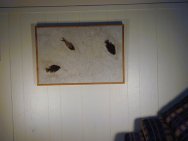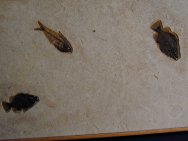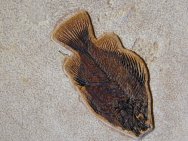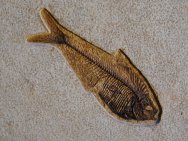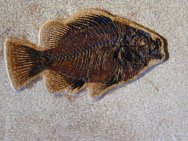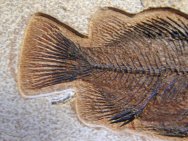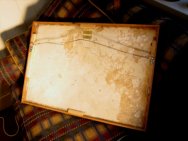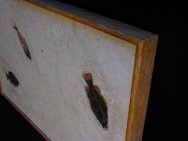| 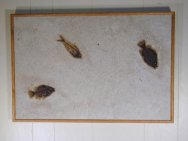 Description:
This is a fossil showpiece in an oak frame ready to hang in home
or office. It contains three especially well preserved fish fossils,
two Priscacara and one Diplomystus, all aesthetically spaced on
the large 27.5 by 18.3 inch plate. The 1.6 inch deep oak frame is
equipped with a heavy wire hanger. All-in-all, a magnificent fossil
showpiece and decorative gem. The specimen is shipped in a custom-made
crate measuring 33.5 by 24 by 6.5 inches securing its safety now
and in the future. Description:
This is a fossil showpiece in an oak frame ready to hang in home
or office. It contains three especially well preserved fish fossils,
two Priscacara and one Diplomystus, all aesthetically spaced on
the large 27.5 by 18.3 inch plate. The 1.6 inch deep oak frame is
equipped with a heavy wire hanger. All-in-all, a magnificent fossil
showpiece and decorative gem. The specimen is shipped in a custom-made
crate measuring 33.5 by 24 by 6.5 inches securing its safety now
and in the future.
These
50 million year old, Eocene-Era fossil fish come from one of the
world's famous Laggerstatten, the Green River Formation in Wyoming.
A small portion of the fish fossils from Green River exhibits such
fine preservation. The significant extent of soft-tissue preservation
that makes the site famous is evident in this specimen.
Genus
Priscacara is perhaps the most popular of the Green River fish fossils.
A member of the Family Priscacaridae, the name Priscacara means
"primitive head". Shaped rather like a sunfish, the genus
sports sturdy, protective dorsal and anal spines. Among the two
species, liops and serrata, serrata is uncommon. The species name
comes from the diagnostic serrated preopercle, seen here in closeup.
Liops is the smaller species, never exceeding 150 mm, whereas serrata
have been found up to 375 mm. The genus went extinct at the end
of the Miocene, and is thought by some to be related to the modern-day
Cichildae.
Early
workers proposed that genus Diplomystus was closely related to Knightia,
an incorrect assumption, as Diplomystus is not even placed within
the same Order. Diplomystus has the body form and mouth placement
of a surface feeder, as is thought to have been a predator of smaller
surface-feeders such as Knightia. Indeed, specimens of Diplomystus
have been found with Knightia in their stomachs or mouths, a classic
demonstration of a predator caught by its prey!
| Shipped
in styrofoam lined Custom Crate: 50 pounds & 34 x 25 x 7
inches |
|

